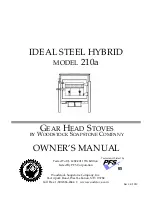
The Ideal Steel Hybrid Combustion System Explained
The Woodstock Soapstone Company’s tradition of build-
ing high quality, dependable wood stoves continues in the
Ideal Steel Hybrid Wood Stove. This new design combines
modern technology to achieve clean and efficient heating
performance with rugged reliability and affordable steel con-
struction.
While the Ideal Steel Hybrid shares some time tested fea-
tures with other members of the Woodstock Soapstone fami-
ly, it also includes some features that are unique. The Ideal
Steel Hybrid has a large glass front that benefits from our
proven air-wash design, but unlike our other wood stoves,
the glass front is also a large loading door. The door swings
open wide for access to a large firebox which can be loaded
front-to-back or side-to-side, depending on the length of your
wood. Innovative andirons protect the glass and can fold out
of the way when the door is opened for loading. The firebox
can be lined with thick soapstone panels or firebrick, and the
exterior is plate steel in order to make the Ideal Steel Hybrid
more affordable.
The Ideal Steel Hybrid has a hybrid combustion system
similar to the one that we pioneered in our Progress Hybrid
wood stove. The combination of the catalytic combustor and
the secondary combustion system gives the operator a wide
range of heat output while maintaining a clean and efficient
burn. In addition to the Hybrid combustion design, the Ideal
Steel Hybrid incorporates new automatic catalyst air to opti-
mize the catalytic combustor’s effec-
tiveness.
Hybrid burn technology
improves efficiency, lowers emis-
sions, and allows for a wider range
of output to meet the heating needs
of the operator. Hybrid stoves from
Woodstock combine the best attrib-
utes of both catalytic combustors and
secondary combustion systems. A
brief description of each is below, fol-
lowed by a more detailed explana-
tion.
Catalytic Combustion:
• Burns woodstove exhaust gases
starting at 500
O
F
• Operates best at low to moderate
burn rates
• Typically yields long duration burns
that are clean and efficient
• Improves stove efficiency by
generating heat from burning
wood smoke
Secondary Combustion:
• Burns woodstove exhaust gases
starting at approximately 1000
O
F
• Operates best at moderate to
high burn rates
• Creates hot firebox for maximum heat output
• Provides a very active fire that is great for viewing
Catalytic combustors are well suited for very long burn
cycles. Catalytic combustors have the ability to reduce or
eliminate woodstove pollution at low stack temperatures.
This means much cleaner, more efficient burns at low firing
rates than is possible without a catalyst. The catalytic reaction
eliminates harmful combustion byproducts and converts
exhaust to water vapor and carbon dioxide. The catalytic
combustor burns exhaust gasses and converts them to heat,
which is captured inside the stove. This extra heat increases
the overall efficiency and output of a catalytic wood stove.
The combustor takes full advantage of the energy in wood
smoke that would otherwise be lost up the chimney as pollu-
tion and wasted energy at low burn rates.
Secondary combustion systems are designed to maximize
efficiency and reduce emissions as well, but they operate dif-
ferently. The secondary combustion system introduces sec-
ondary air in the firebox to ignite the volatile gases produced
by the burning wood. This reaction requires temperatures
over 1000 degrees F to start breaking down the organic com-
pounds in the wood smoke. Secondary combustion systems
work best when the stove has high firebox temperatures and
secondary combustion air introduced into the high tempera-
ture area at the top of the firebox. With secondary combus-
tion the exhaust gases burn at very high temperatures before
leaving the firebox, providing an unusual display of second-
ary flames in the top of the firebox.
In addition to primary and secondary air, the
Ideal Steel Hybrid incorporates a system to intro-
duce air directly to the catalytic combustor as it
heats up. When the catalyst is fully engaged a self
adjusting, bimetallic coil opens a small damper to
allow heated air into the exhaust path just
upstream from the combustor. This dedicated “cat-
alyst air” keeps the combustor active and helps
control primary and secondary burn rates. As the
stove and chimney heat up and draft is increased,
more catalyst air is added automatically. This has
the effect of stabilizing primary and secondary air
and at higher temperatures will actually reduce
primary and secondary air. The catalyst air design
acts similar to a barometric damper.The catalyst air
improves emissions and efficiency at high burn
rates, provides overfire protection, and stabilizes
the burn rate- automatically.
These systems are not mutually exclusive and
have been designed to work together. The Ideal
Steel Hybrid is designed to utilize each system
depending on the conditions present in the fire-
box. This makes operating the Ideal Steel Hybrid
as simple as possible while providing a clean and
efficient burn over a wider range of heat output.
The Ideal Steel Hybrid wood stove. The perfect
combination of affordability, innovative combus-
tion technology, and rugged construction.
INTRODUCTION
Catalytic bypass open
Three sources of combustion air:
1. primary air,
2. secondary air, and
3. catalyst air
1
2
Catalytic bypass closed
(combustor engaged)
1
2
3
Once the catalytic combustor is engaged,
smoke from the primary & secondary burn
will be directed through the catalytic com-
bustor. The catalyst air will help keep the
combustor operating at peak efficiency.
3





































